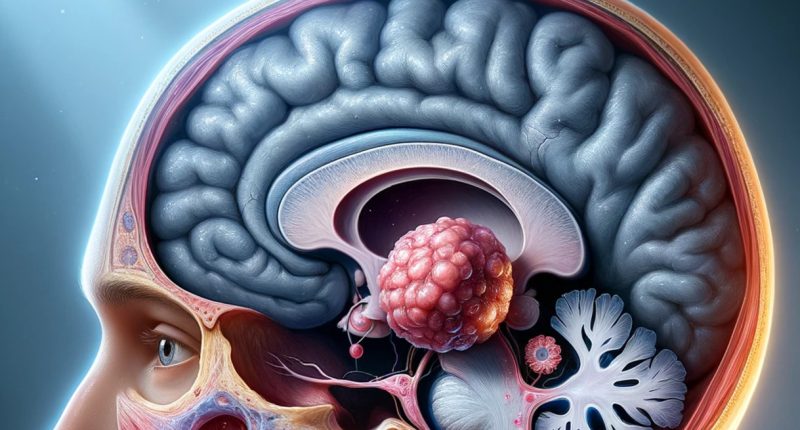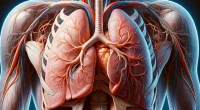Pituitary adenoma
What is a pituitary adenoma?
A pituitary adenoma is a benign tumor that develops from cells in the anterior part of a pituitary gland. In many cases, it isbeen asymptomatic for decades. It is detected sporadically, but sometimes, it is associated with specific manifestations that significantly reduce the quality of life in several people.
Pituitary adenomas are among the most common intracranial neoplasms, accounting for about 10-15% of all brain tumors. They originate from the cells of the pituitary gland and are typically slow-growing. To avoid complications of this disease, if specific symptoms appear, you should have a consultation of an endocrinologist, optometrist, or neurologist (depending on the manifestations). Your doctor will perform an examination, find the correct diagnosis, and prescribe the most effective treatment regimen for treating pituitary adenoma in your situation.
Disease
The pituitary gland is a part of the brain, one of the principal organs of endocrine function, the gland is responsible for the production of growth hormones, reproductive and metabolic processes. Four out of five pituitary tumors are adenomas. They develop in people of both sexes, often between 30 and 40, and are relatively rare in children.
About 20% of pituitary adenomas in men and women do not manifest in any way, and it turns out to be an accidental diagnostic finding during an examination because of different pathology.
Classification
Depending on the origin, the following types of pituitary tumors are distinguished:
- primary pituitary cells (pathologically dividing cells are initially localized to the pituitary gland);
- secondary (occurring due to hyperfunction of the hypothalamus or failure of peripheral organs of the endocrine system).
Also, tumors are characterized by their size:
- microadenomas (less than 10 mm in diameter);
- macroadenomas (more than 10 mm in diameter);
- giant macroadenomas (6 cm or more).
According to clinical signs, tumors in this area of the brain are of two types – hormonally active and passive. The first occurs when damage occurs to parts of the gland that produce a specific hormone; in the second case, the tumor affects cells that do not produce hormones, affecting the disease’s clinical picture.
The classification of hormonally active pituitary adenomas includes the following types of tumors:
- a prolactin-producing adenoma (35-45%);
- growth hormone-producing somatotrophinomas.
- ACTH-producing corticotropinomas;
- sex hormones – gonadotropinomas;
- producing thyroid hormones – thyrotropinomas (1-2%);
- mixed (secretes several hormones at the same time).
Symptoms
Signs of pituitary adenoma can be divided into two broad categories: ophthalmologic-neurologic and endocrine. The former occurs when a growing tumor compresses nearby brain parts and depends on the function of which part of the central nervous system is affected. The latter has symptoms of hyperproduction of one or more of the abovementioned hormones.
So, ophthalmologic and neurologic symptoms of pituitary adenoma can be:
- headaches, especially in the front and/or temporal areas, persistent, not responsive to painkiller use;
- nausea and vomiting.
- loss of visual acuity;
- double vision;
- change in the field of vision.
- ocular motor nerve disorders (limited scope of movement of the eyeballs);
- persistent nasal congestion (when the tumor sprouts from tissue in the ethmoid or sphenoid sinuses);
- when the hypothalamus is affected, there is a breach of consciousness.
The manifestations of endocrine-switching syndrome directly depend on the cellular structure of the hormone-active tumor:
- prolactinoma symptoms of pituitary adenoma in women include menstrual disorders, infertility, galactorrhea, seborrhea, obesity, decreased libido, in men – growth of the size of the mammary glands (gynecomastia), galactorrhea, erectile dysfunction, decreased libido;
- somatotropinoma is accompanied by an increase in growth, which is called gigantism (in children), and whole individual body parts, which is called acromegaly (in adults); patients have increased body weight, may develop diabetes, thyroid disease, oily skin, hyperhidrosis, polyneuropathy;
- With corticotropinoma, patients complain of obesity, with fat deposition in the form of an apron, stretch marks on the thighs and abdomen, increased blood pressure, frequent bone fractures, areas of atrophy, increased skin pigmentation, a tendency to pustular infections and fungal lesions;
- thyrotropinoma is characterized by symptoms of hypothyroidism (generalized weakness, drowsiness, bloating, drowsiness, low mood) or hyperthyroidism (irritability, sweating, insomnia, body tremors, palpitations);
- gonadotropinoma mainly produces biologically active hormones, so its main manifestations are ophthalmic-neurological; sometimes, it is accompanied by galactorrhea and signs of hyperstimulation-ovarian hyperstimulation syndrome.
Causes of pituitary adenoma
The exact causes of pituitary adenomas are not yet clear to researchers. It is known that this tumor, in most cases, is not hereditary, but it can be an indicator of several genetic syndromes. The following factors increase the risk of its development:
- head injuries;
- infectious diseases of the central nervous system (encephalitis, meningitis, leptospirosis, etc.);
- contraceptive pills;
- abnormal during pregnancy and childbirth;
- poisoning with poisons and toxins;
- changes in hormone production by the peripheral endocrine glands.
Diagnosis of pituitary adenoma
Women and men with symptoms of pituitary adenoma usually initially go to a neurologist, ophthalmologist, or endocrinologist, depending on the specifics of the clinical symptoms. Ideally, to clarify and confirm the diagnosis, such patients need to be examined by each of these specialists.
First, the doctor talks with the patient, listens to the complaints, and determines how long and in what order they appeared, how they changed over time, what the patient tried to alleviate their condition, and with what results. The specialist is interested in the co-morbidities of the person and the hereditary pathology that affects their relatives. Then the doctor will perform an objective examination – examining the patient, assessing their body type, color and other skin characteristics, performing palpation and percussion on the affected body part (if necessary).
Based on the information obtained, the doctor will mentally be able to form a picture of the disease, suggest what diseases may be present in their patient, and, depending on this, appoint a research program that will allow them to clarify the diagnosis. It may include:
- a general blood test;
- biochemical blood tests (indicators of protein, carbohydrate, lipid metabolism, evaluation of the hormone levels – sexual, thyroid, glucocorticoid);
- radioimmunological study of pituitary hormone levels using a labeled radioactive isotope;
- radiological examination (the primary method for diagnosing pituitary adenoma of the brain) – X-ray, MRI, CT scan, angiography of the brain vessels – depending on the clinical situation;
- consultations with specialized specialists – endocrinologist, radiologist, ophthalmologist.
Only a holistic, individually-oriented approach to diagnosis will allow a doctor to make the correct diagnosis and prescribe effective treatment for the patient.
Treatment
So, conservative treatment involves the use of medications by the patient that allow normalization of the increased level of a particular hormone. It is most often used for adenoma. The goal of drug therapy is to reduce the size of the tumor and minimize the symptoms of increased prolactin production.
The goal of surgical treatment is to remove the tumor cells. It can be performed transcranially (by skull trepanation) or transnasally (through the nose). In the latter case, endoscopic equipment is used.
This disease can be treated with a Endoscopic pituitary surgery, which is performed in 630 hospitals around the world. (https://doctor.global/results/procedures/endoscopic-pituitary-surgery). The average cost of this surgery in Turkey is $11.8 K, based on the calculation from 30 clinics (https://doctor.global/results/asia/turkey/all-cities/all-specializations/procedures/endoscopic-pituitary-surgery)
The conservative treatment option is radiotherapy. It is used as an adjunct to surgery or as a method of choice for patients for whom surgery is contraindicated.
The modern way to treat pituitary adenomas in men and women is radiosurgery with a gamma knife. A radiation beam is directed at the tumor area and destroys atypical cells. The operation is low-traumatic, is performed on an outpatient basis, does not require general anesthesia, does not lead to the development of complications, and does not reduce the patient’s quality of life after the intervention. It can be used as the method of choice for treating exacerbations of pathology.
Rehabilitation
After classical surgical treatment of an adenoma, the patient remains in the hospital for several weeks under the supervision of medical staff. After discharge from the ward (if conservative or radiotherapy was used – for recovery), the patient needs to be dynamically monitored by a neurologist, endocrinologist, or neuroendocrinologist – periodically appearing for an examination by a physician and undergoing the necessary minimum investigations for a timely diagnosis of possible recurrence of the tumor.
Prevention
There are no specific preventive measures for pituitary adenoma. To reduce the likelihood of contracting this disease, you should avoid exposing your body to factors that provoke it and pay attention to your health, when specific symptoms of the disease appear, do not delay, but consult a doctor for diagnosis and treatment recommendations.
Research and Future Directions
Research in the field of pituitary adenomas is ongoing, focusing on understanding their development, improving diagnostic techniques, and finding novel treatment approaches. Genetic research is particularly promising in identifying individuals at risk and developing targeted therapies
Conclusion
Pituitary gland adenomas, while generally benign, can have significant impacts on health due to their hormonal effects and physical presence in the brain. Advances in medical science have led to effective treatment modalities that significantly improve the quality of life for those affected. Ongoing research and patient education remain key to further advancements in the management of these common brain tumors. With continued focus on innovation and patient care, the future holds promise for even more effective and personalized approaches to managing pituitary gland adenomas.




